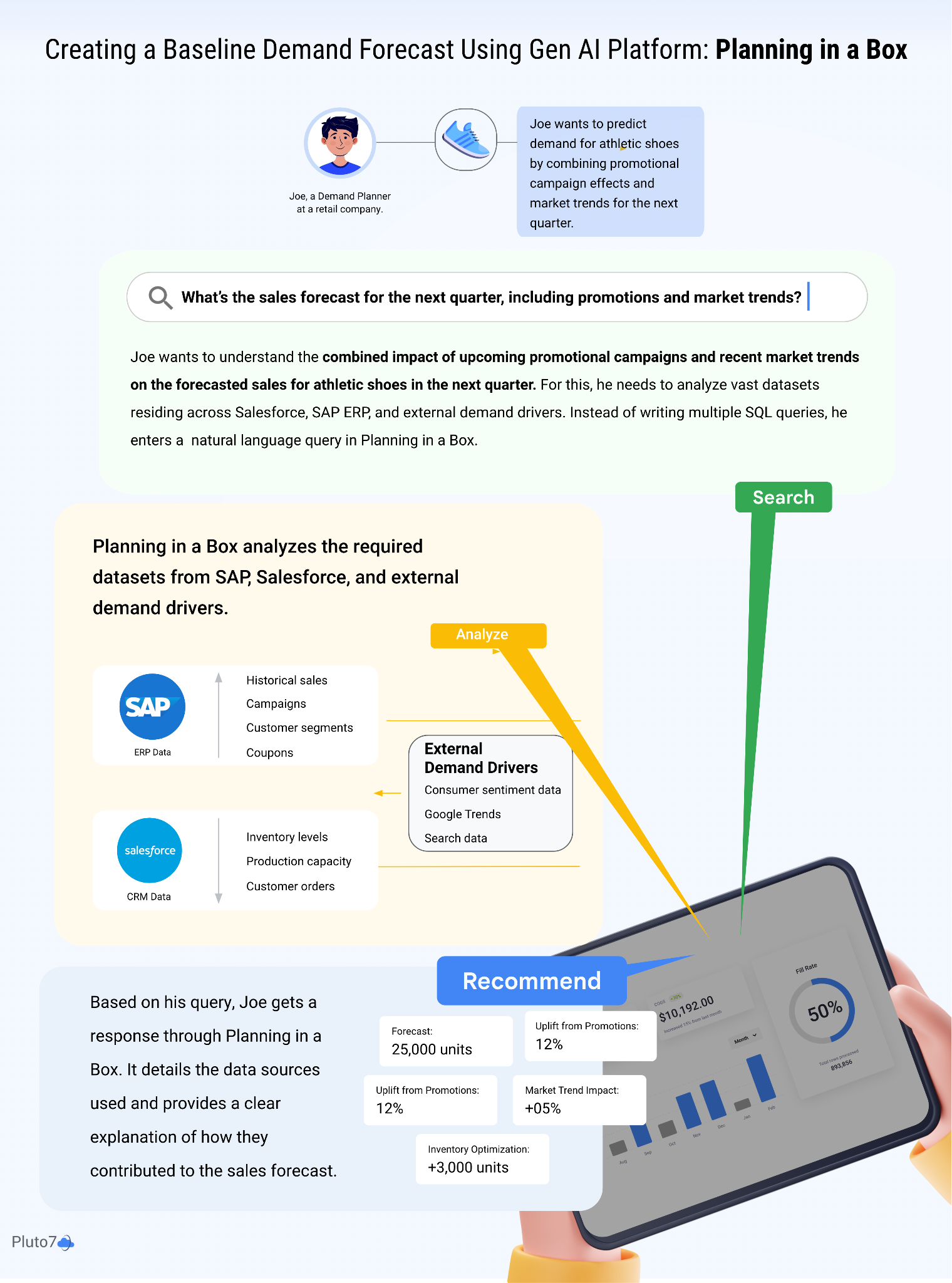
Transform Your Supply Chain Planning and Marketing Strategies with Google Cloud and SAP Integration

Transform Your Supply Chain Planning and Marketing Strategies with Google Cloud and SAP Integration
March 18, 2024 | Premangsu Bhattacharya
Blog / Top 5 Ways Sales History Data Can Boost Your Demand Forecasts
In the movie “Back to the Future,” Marty McFly uses a DeLorean time machine to navigate the past. Businesses, while lacking a flux capacitor, possess a powerful tool with a similar effect: sales history data. This vast trove of information offers a window into past buying behaviors, trends, and patterns – invaluable assets for predicting future demand. Let’s delve deeper into how sales history data can transform your demand forecasts from educated guesses to data-driven insights.

Joe, a demand planner for a sporting goods company, faces a challenge. He needs to forecast sales for athletic shoes in the upcoming quarter. To complicate things, a new line of running shoes is planning an aggressive marketing campaign, coupled with recent whispers of a rising interest in athleisure wear.
Here are 5 ways Joe, and any other demand planner in his shoes, can tap into sales history data to make more accurate forecasts for those athletic shoes. While we’ll use Joe’s example throughout these points, these techniques apply to any product category. Let’s dive into the specific methods.
Joe investigates the sales data, focusing on historical sales of athletic shoes. He identifies trends—a surge in sales typically occurs in the spring, coinciding with the start of outdoor fitness activities. He also observes a smaller peak in the fall, potentially linked to back-to-school shopping. By factoring in seasonality, Joe establishes a baseline for athletic shoe sales in the upcoming quarter.
Joe segments customers who buy athletic shoes. He identifies runners seeking stability shoes and weekend warriors focused on lightweight styles. He analyzes past purchases within these segments to predict which groups are most likely to be interested in the new running shoes planned for launch, refining his forecast for each customer segment.
Joe analyzes historical data for past athletic shoe promotions. He discovers a 20% discount during a summer sale led to a significant increase in sales. He uses this insight to recommend a similar discount strategy for the upcoming launch of the new running shoes, potentially boosting his sales volume forecast.
Joe discovers a slight price increase on a specific running shoe style during a previous season resulted in a minimal sales drop. This empowers him to recommend a strategic price point for the new running shoes, allowing him to predict not just volume but also potential revenue based on customer price sensitivity.
Joe encounters a competitor offering a free gift with purchase, which could lead to a short-term dip in sales for his company. This knowledge empowers him to be proactive, potentially recommending a counter-promotion to maintain market share and achieve his forecasted sales goals.
Now, to leverage all these data points and to do it fast, demand planners like Joe needs a platform that acts as his data refinery. He needs a system that can ingest information from various sources but, more importantly, ensure it’s clean, organized, and ready for analysis. Data modeling and machine learning capabilities would be a huge plus, allowing Joe to uncover hidden patterns and automate tasks for even faster insights.
This is where Planning in a Box comes in.
Planning in Box eliminates data headaches. It pulls data from multiple sources, cleans it for accuracy, and uses Gen AI to get you the answers you need – fast. This means planners spend less time finding the data or writing complex SQL queries.
Planning in a Box lets you create scenarios based on real-time or constantly updated data. It integrates with live data sources, ensuring your “what-if” scenarios for pricing, marketing, and competitor actions are based on the latest market conditions.
Planners typically rely on marketing teams or external data sources to understand customer segments. Planning in a Box automates this process using AI, saving the planner significant time and effort. It also goes beyond basic demographics, uncovering hidden segments based on real purchase behavior.
Traditional forecasting methods often rely on broad averages that can miss the nuances of different customer segments. Planning in a Box allows the planner to create forecasts that are tailored to each segment’s unique buying behavior. This reduces the risk of inaccurate forecasts and leads to a more realistic picture of future demand.
Planning in a Box uses AI to complement your work, not replace it. You can see the data behind the AI insights, adjust the models to fit your specific needs, and slice and dice the data further for deeper exploration.
Planning in a Box slices through the usual hassles of data transformation. If you’re currently using SAP IBP for forecasts, for example, it will quickly connect with it, enabling features such as advanced analytics, real-time scenario planning, and integration with external datasets—capabilities that may not be as accessible or available with IBP. And it’s just as compatible with any other forecasting tool you might be using.
To learn more about Gen AI Planning Platforms and how they can benefit not just you but your entire supply chain organization, sign up for our free workshop.
ABOUT THE AUTHOR